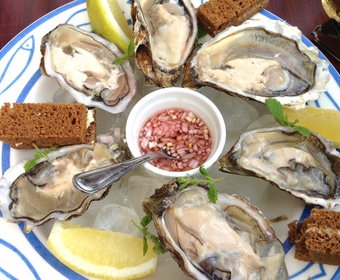
Opening oysters like a pro
The first bit of advice when opening oysters is to practice on yourself before offering to open them for someone else. An oyster full of chips of shell and where most of the juice has spilled over the floor is not the fun, fresh, luxurious experience you or your guest are looking for. These are the bits where it’s worth putting in some practice:
Preparation
Get an oyster knife with a short, firm blade and preferably a protective glove for the hand holding the oyster (Kevlar is good). You also need a clean, dry tea towel. Also prepare so that the opened oyster gets quickly to a beautiful bed of ice, and gets just as quickly out to the guests – as fresh as it can possibly be.
Wash the oysters in cold water with a stiff brush.
The next part looks so easy when the professionals do it, but be warned, it takes a bit of effort:
Opening
Place the oyster in a folded tea towel with the flatter half of the shell upwards so that as little as possible of the oyster’s juice runs out when you open it. Fold the doubled cloth over the oyster so you are tackling the oyster a little further back, close to where the shell is “threaded”. (Belon oysters are an exception, when opening them you should insert the knife into the actual "hinge" at the back.)
Grip the oyster hard with the help of the towel with your free (and protected) hand. Find the crack, force in the knife. When the knife is in, turn it so that the “thread” let’s go and the oyster opens. But you’re not finished yet:
Run the knife along the flatter upper shell to cut off the oyster’s muscle. Once you have got the flat “lid” off, run the knife (make sure it is clean and you aren’t leaving bits everywhere) deep down along the inside of the lower shell so the oyster loosens completely from the shell. The aim when serving raw oysters is always for the guest to be able to slurp down a dainty mouthful without getting a mouthful of crunchy bits of shell.
Two small tricks:
We got these tips from a restaurateur in Bretagne who opens hundreds of oysters every day:
- Hold the knife so that you are "pinching" the blade – between thumb and forefinger – close to the top so that the sharp tip is only about 20 mm or less. Now try introducing the sharp point into the back of the oyster where the muscular "joint" is situated. In this manner you minimise the risk of using too much force and stabbing yourself in the hand holding the oyster. You apply less force and more technique.
- You can also try keeping your knife hand still and steady, and working and twisting gently with the (protected) hand holding the oyster.
If it all goes wrong:
If you can’t get the knife in or the oysters split and fall apart, try putting the knife into the wider “front side” of the oyster. Then run the knife along the top shell to force apart/cut off the thread at the back. This can work but you also risk getting bits of shell in the opened oyster.
Use the towel to remove any bits of shell on or in the oyster.
More help
A short and concise film on opening oysters can be found here (but it won’t replace practice):
https://www.youtube.com/watch?v=siacUm1_2rc


